The Giro route is out and a quick glance shows the usual route with a loop towards the south and then the passage through the Alps before the finish. Look more closely and the route is more intriguing with new climbs, an unmentioned gravel road plus a record amount of vertical metres and three time trials stages to compensate.
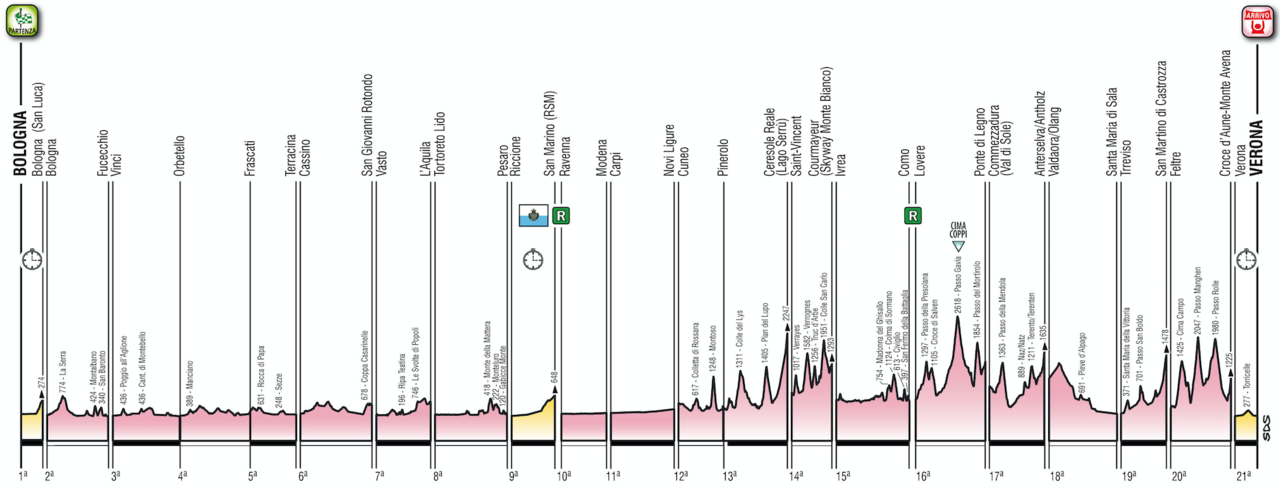
We knew about the start in Bologna and the 8km time trial to the San Luca basilica but its context changes, this is one of three TT stages and 56km in total of solo time trials, in line with the average for the Giro in recent years. Stage 1 will prise open gaps and the sprinters will easily lose 30-40 seconds on the slopes of the San Luca but will have the coming days to try and take the maglia rosa. Stage 2 won’t suit every sprinter as it has a couple of late climbs, a touch of Milan-Sanremo. Stage 3 is open to all the sprinters. Stage 4‘s finish in Frascati is uphill with 4km at 4% including a solid 6% for the final kilometre, a Sagan-esque finish. Stage 5 is another for the sprinters.
Stages 6 has a 15km climb averaging 4% before the finish which should drop some sprinters and Stage 7 returns to earthquake-hit Acquila with some climbs to shake out a few sprinters too. Stage 8 to Pesaro is the race’s longest and has some late climbs again to spice things up borrowing the same coastal road from Gabbice to Pesaro used in 2013 when Alex Dowsett was the surprise TT winner ahead of Bradley Wiggins. All this makes for a week of racing without a summit finish, unusual for the Giro and a lot of bunch sprints, but possibly among 50 riders rather than 150 on some days.
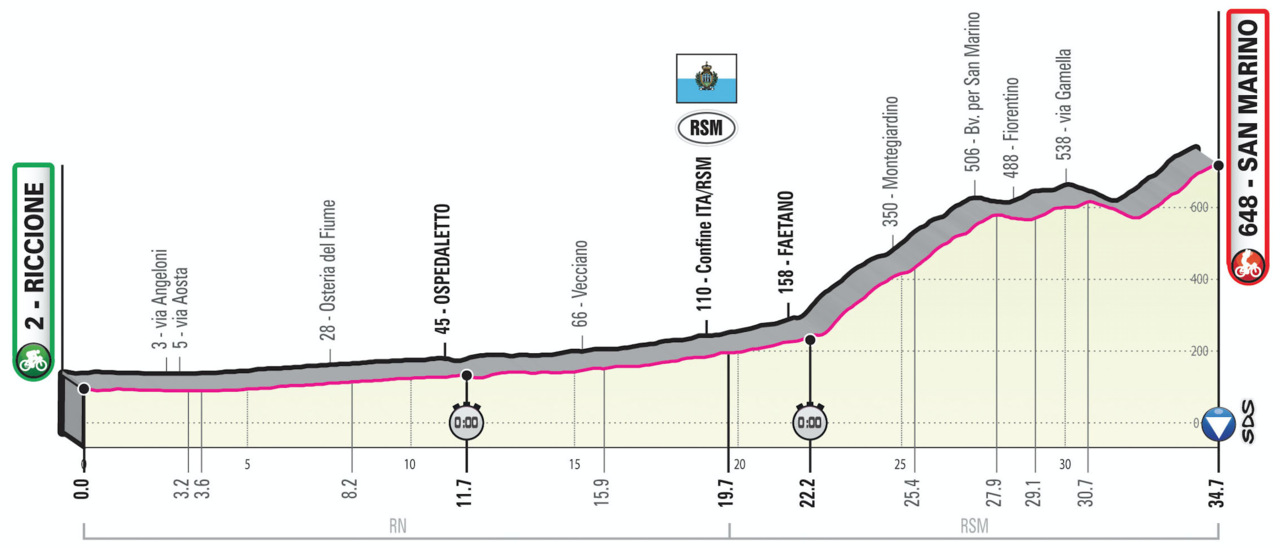
Stake 9 is the “wine stage” to celebrate the sangiovese grape and more importantly a 34km time trial to the microstate of San Marino with about 900m of vertical gain. After a flat start on the Adriatic coast the course heads inland once inside San Marino the climb will bite with 5-7% slopes. It’s the sort of course where all riders will use a TT bike but the climb will pick the winner. Stages 10 and 11 are as flat as a piadina and compensation for the sprinters who lost out on the hillier early stages but also a likely exit point for the sprinters as there’s only one sprint stage left and many will make their polite excuses and take the autostrada to Milan for an evening flight home.
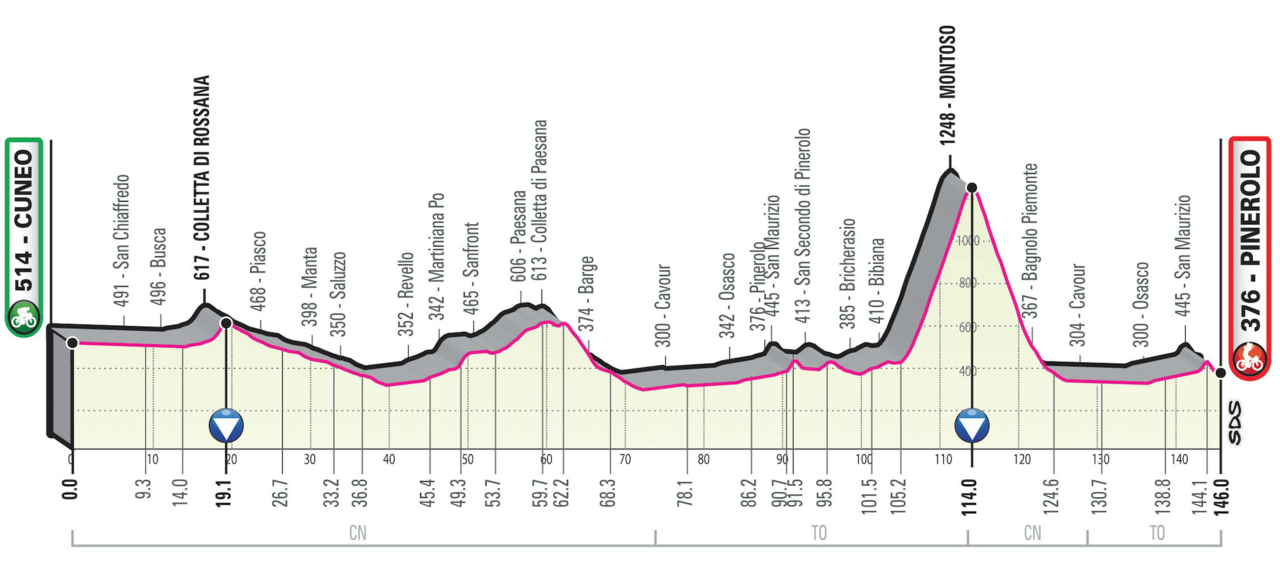
Stage 12 and the Giro gets vertical. The theme of the Cuneo-Pinerolo stage is Fausto Coppi’s 1949 raid between the two towns although that happened in the Alps, this stage crosses the plains for the most part before the sharp climb to the tiny ski station of Montoso and 10km at 7% with some sustained 10% sections before the top, a selective climb chased by a twisty descent and 20km across the plains to the finish before Pinerolo and the tricky 20% cobbled “wall” that was used before in 2016.
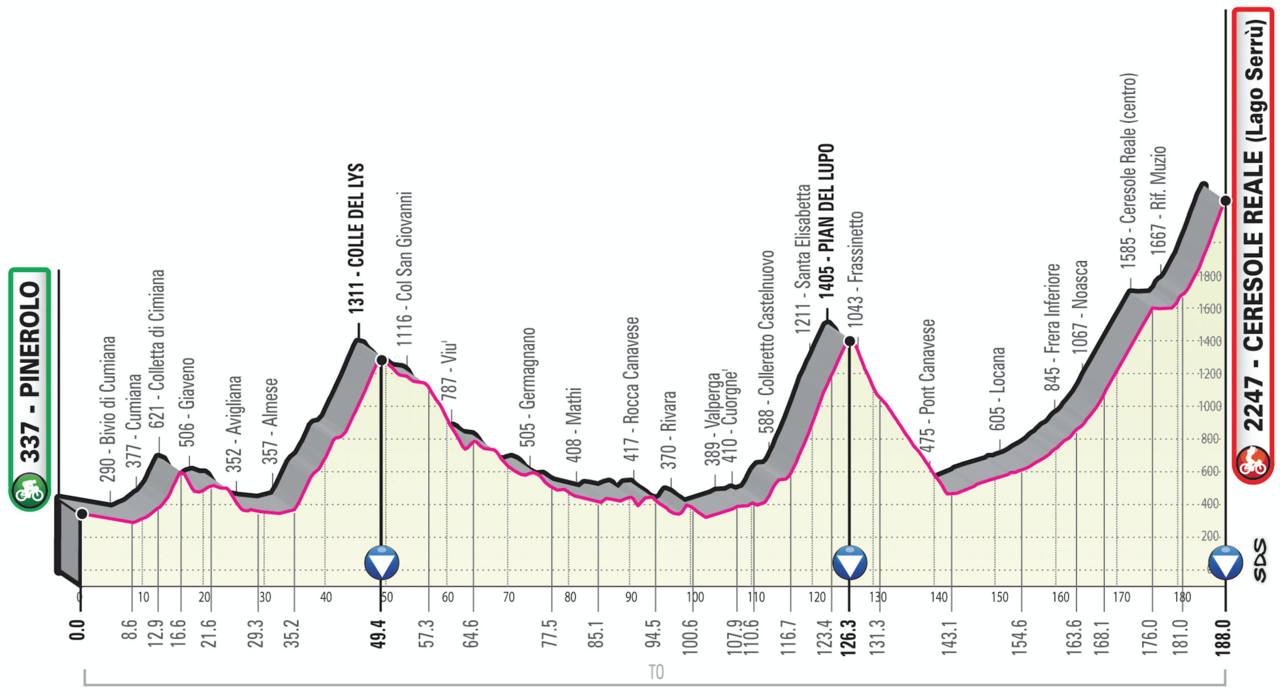
Stage 13 is the one to watch at all costs as the Giro explores new roads. First a familiar road in the Colle del Lys, used in last May’s Giro when it was climbed at warp speed in the other direction on the way to the Finestre, this time it’s the steeper side and 12km at 7.5% but look closely at the profile above and there’s a little balcony moment, in fact it’s a descent meaning the slopes of this climb are typically 8-9% but there’s a long time to recover and regroup before the Pian del Lupo, “wolf field” and a surprise or two with 9.4km at 8.7% and long ramps above 10% before the top where the slope levels out more than the spiky profile suggests and I don’t think anybody has noticed that there’s a gravel road across to the descent, perhaps it’ll be surfaced in time for the race? Then comes the Orco valley, once famous for gold panning, and now finally on the map for the Giro. This blog’s Roads to Rides series features roads used in races around the world with the exception of the Colle del Nivolet, added because it’s an amazing road but has yet to be used in a pro race. This changes but they don’t go all the way to the top of the pass, just to the Serrù dam which is plenty at 2,250m above sea level and lets cicloamatori boast they’ve done more than the Giro. Still without the upper slopes it means a large wide road up the valley and after tackling the repaired road outside the tunnel at 9%, a flat section past the Ceresole lake helps a strong team keep a lid on things until the final slopes.
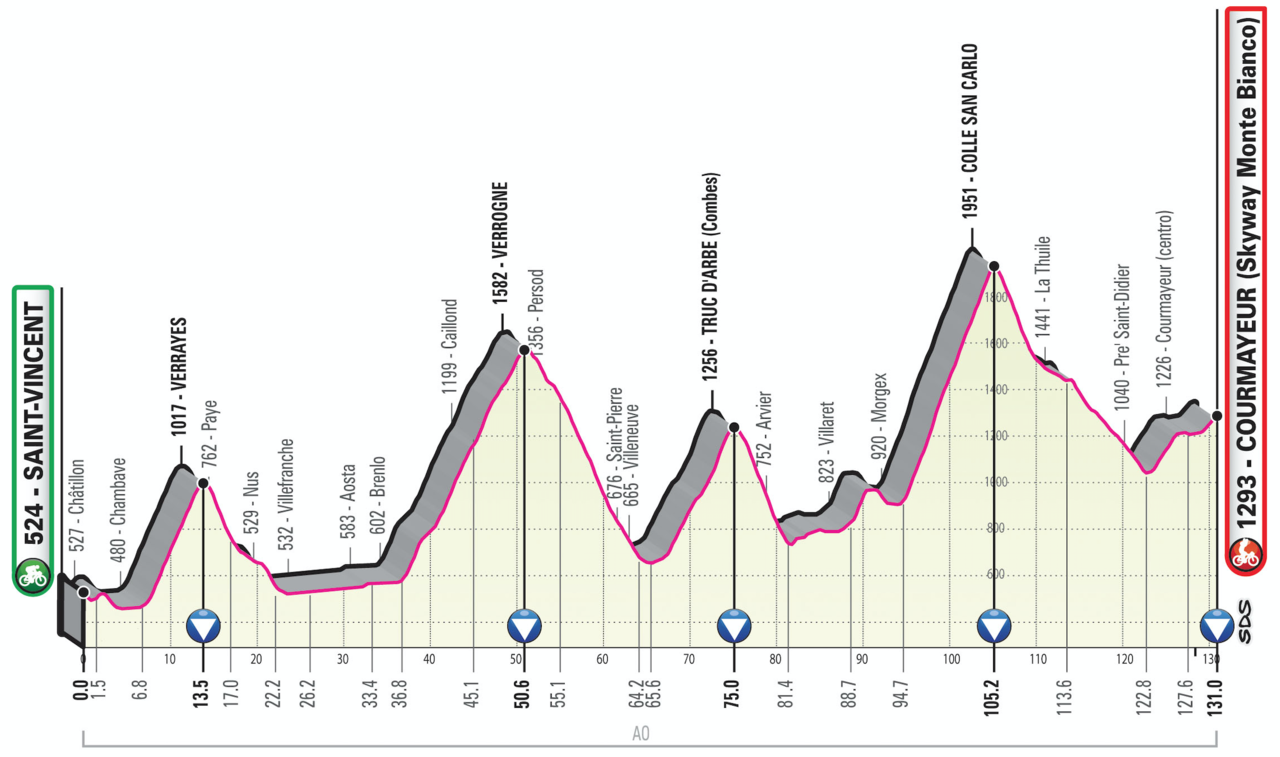
Stage 14 and the Giro borrows from the trend to short stages with just 131km as they head up the Aosta valley with its microclimate and vineyards and instead of staying in the valley floor they sashay up the sides first via the lower slopes of the Col de San Pantaleon to Verrayes, then the loop via Verrogne then back up the other side of the valley around Combes before tackling the Colle San Carlo, a rarely used climb in the Giro but familiar to many in the peloton from regular use in the U23 Giro della Valle d’Aosta. It’s a sustained steep climb, the slope bites from the start and then it just gets steeper with long sections above 10% before dropping down to pick up the Col du Petit Saint Bernard’s hairpin heaven descent down to the Aosta valley and then a ride up the valley to Courmayeur for the flattish finish.

Stage 15 involves a change of pace with a copycat stage of Il Lombardia via the Madonna del Ghisallo, Sormano (but the main road, not the wall) and then Civiglio and San Fermo della Battaglia and a good day for the breakaway.
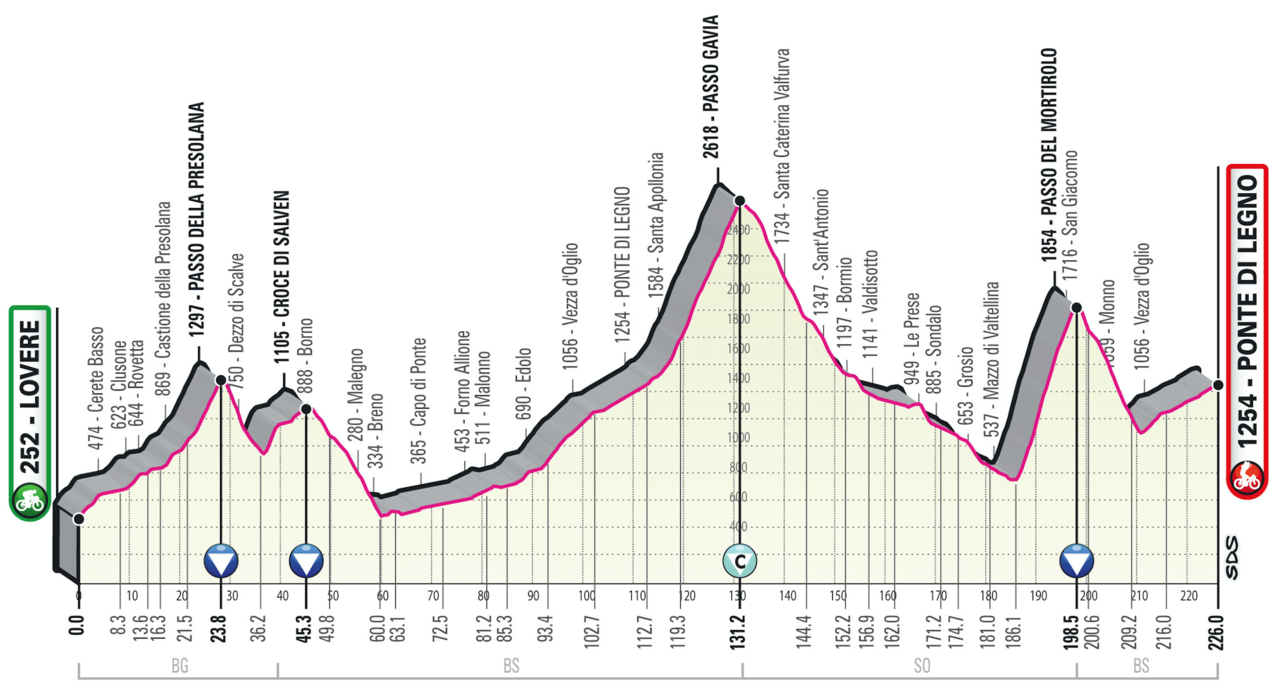
Stage 16 and it’s back to Alpine racing via an anthology of climbs, notably the Passo Gavia – the Cima Coppi for 2019 – and the Mortirolo and if there’s no summit finish in Ponte di Legno, many will have wooden legs by the end of this 226km marathon and Mortirolo will thin things down.

Stage 17 and a day for the breakaway, the stage is Alpine but a pause between the high mountains and despite the profile, no summit finish either even if there’s 8km uphill at the end including 3km at 8.5%. Stage 18 is one for the any remaining sprinters left in the race and perhaps last chance to shake up the points classification.
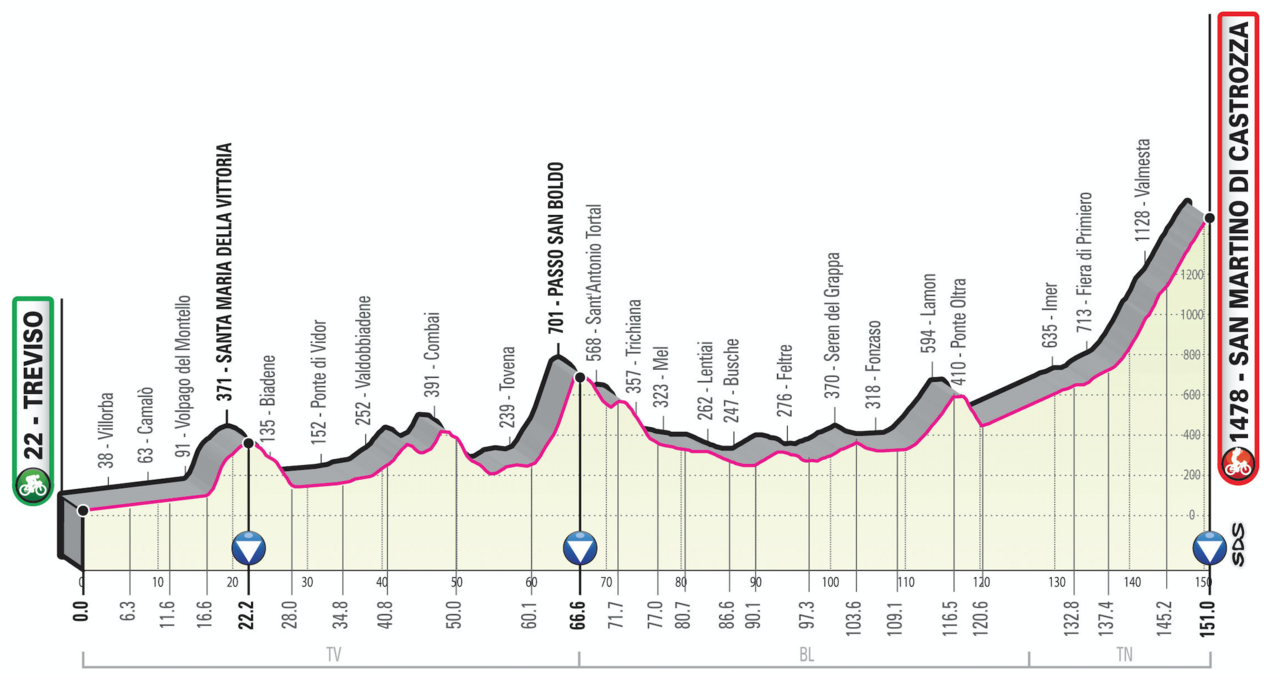
Stage 19 and a trip through the Passo San Boldo. Your normally go over most mountain passes but the San Boldo is a collection of hairpin tunnels, a hastily built road to allow supplies to reach the front late during WW1 and locals, including women and children, were pressed into working day and night to build this. The comes the finish to San Martino, a long drag up at 6%.
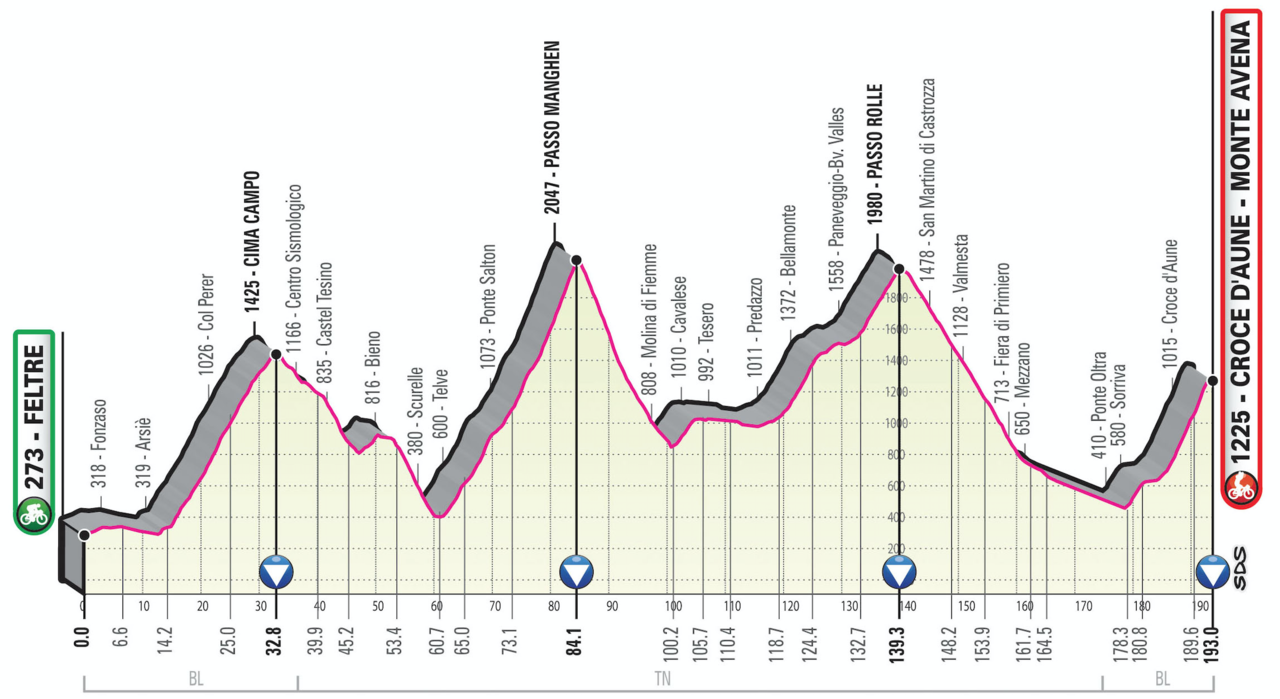
The final mountain stage and Stage 20 is a collection of Dolomite climbs ending on Monte Avena via Croce d’Aune, where if necessity is the mother of invention then Tulio Campagnolo conceived the quick release skewer. This time hopefully there are no mechanicals on the 8% slopes.

Stage 21 and the race ends with a time trial to Verona, a hill in the middle and a route used in the Giro time trials before as well as the World Championships before the finish in the Roman amphitheatre.
The Verdict
A Giro of two halves, the first half has more in common with the Eneco Tour than the usual Giro route, at least technically as it avoids the usual uphill finishes and Apennines are light, a week for the likes of Peter Sagan or Michael Matthews (if they ride). The reason is because the second half is backloaded with vertical gain and the race in total climbs a claimed 46,500 metres, apparently a record for the Giro. The Giro explores new climbs in the Alps with the Nivolet as the big high altitude summit finish and then other stages which have uphill finishes but often the hardest part is the preceding climb.
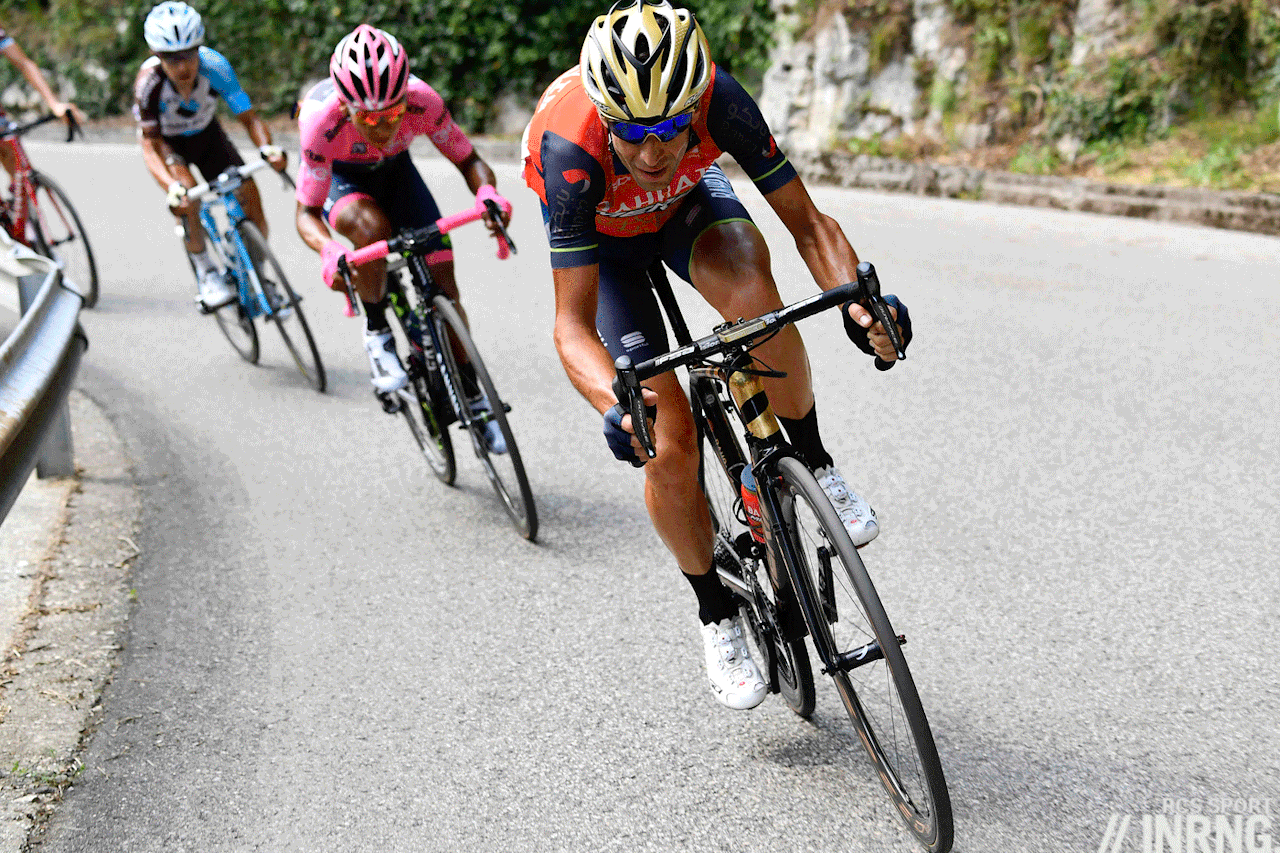
The Contenders
With three time trials and a variety of mountain finishes this is an ideal route for Chris Froome but having ticked off the Giro and Vuelta surely a fifth Tour de France is next goal? Instead Geraint Thomas could try, Sky have yet to decide on the internal politics and as Giro boss Mauro Vegni blurted out last year amid the controversy about the Israel start, an appearance fee could help focus minds. Italian forums say Egan Bernal was spotted in Bologna on his time trial bike, as if he’s practising for the opening stage already and if this sounds precocious several times over so was his start in the Tour de France last July. Tom Dumoulin looks set to ride the Tour de France and if he does he’ll surely need Wilco Kelderman and Sam Oomen for support; a similar story for Dutch rivals Lotto-Jumbo who might go back to the Tour with Steven Kruijswijk and Primož Roglič. Remember that if some tried the Giro-Tour double in 2018, it was helped by the Tour’s start being moved back a week; in 2019 the Giro will start a week later putting the double in trouble, a move designed to help the Giro face fewer climate problems in the Alps but which forces riders and teams to pick one rather or the other. Fabio Aru might see the time trials and sign today for two mountain stage wins given his lack of success but he can surprise against the clock, see Rovereto this year or Megève in the 2016 Tour de France. Simon Yates will be licking his lips at the Tour de France, perhaps Adam is Plan A for May with Esteban Chaves as a joker for Mitchelton-Scott? Astana have hired the Izaguirre brothers and Ion is suited to the three time trials. Movistar are talking about taking El Tridente to France again but Mikel Landa seems keen; can they spare Marc Soler or is Richard Carapaz looking to rediscover his form from this year’s Giro after it vanished in the Vuelta? The trouble here is that the more we speculate it’s as much about whether they’ll start before we consider whether the course suits them. Which leaves Vincenzo Nibali as the obvious contender, he’s due to ride might not have the turbo for the time trials but has the furbo for the mountains and the descents.

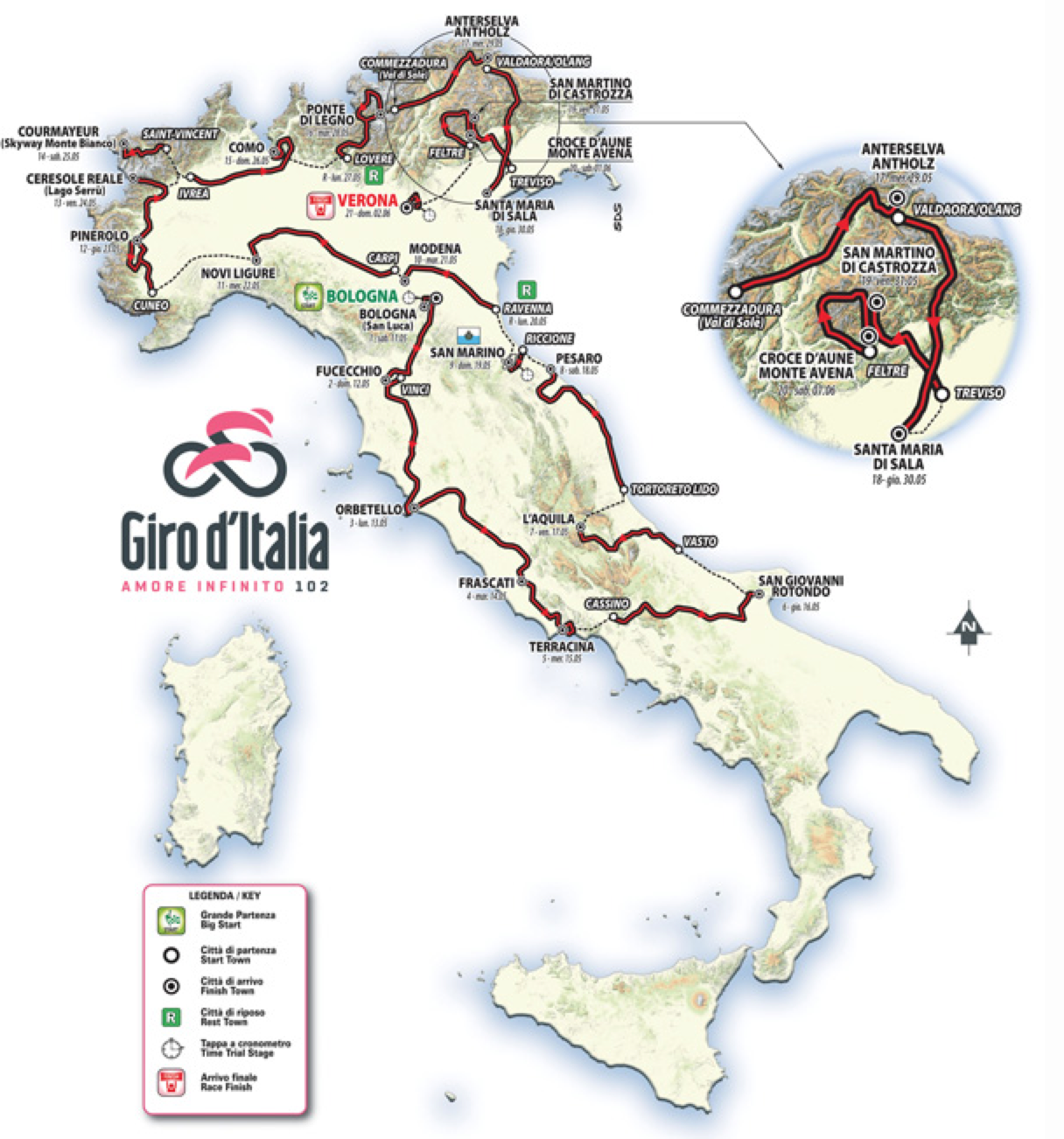
Looks like an excellent opportunity for Roglic to take his first GT. 3 time trials all with hills. He has show very good progression from winning 1 week stage races, to 4th in the tour, now has a route almost built for him. I hope he focuses solely on the Giro and takes the obvious next paste.
paste = step
Perhaps also a good opportunity for Bernal to properly announce himself and start giving some real value for that 12 mill, 5 year contract? And let’s not forget that there was an uphill time trial in the Tour of Romandie this year. Bernal won it, beating Roglic.
It looks a tough course for Bernal to me.
If Froome goes to France, so does the A Team.
The B Team Sky are nothing like as dominant.
Sky do not seem to vary their GT tactics unless forced to, but the train doesn’t run to timetable when the A Team are not driving it.
I could foresee Bernal and even Thomas having a battle on this course, it’s just who their rivals may be.
Intriguing.
Was it the A Team that won the Giro, Ecky? The A Team would include Thomas, who wasn’t there, and now most would also say it had to include Bernal, who wasn’t there. Kwiatkowski has been in the last two Tour teams. He wasn’t there. The A Team road captain is Luke Rowe. He wasn’t there. The team that won the Giro was a kind of B Team with the A Team leader at the head. I don’t think next May will be much different in terms of priorities albeit that probably Thomas or Bernal or both will be the focus of the team that is sent. And even though the one rider this is the perfect course for is Froome.
@RonDe
you’re correct that it wasn’t the A Team, but if memory serves true—and i wasn’t able to follow the race as closely as i normally would have—Froome had a hard time and team support was lacking, hence his mega-attack to win.
so yeah they still won without the A Team, but probably because Froome is/was extraordinary.
Agree with Sam above, it was a do-or-die (so to speak) effort from Froome that gained that win.
For all the griping against Team Sky, they’re not strong enough to dominate both Giro and TdF with separate teams.
A Thomas / Sky v Dumoulin / Sunweb contest here would be appealing, and I’d have the Dutchman down as my favourite.
A balanced route (dare I say showing ASO how it’s done) with – praise be – a genuinely long stage (16) with multiple climbs (although it could do with one or two more, ideally). Grand tour winners should be able – and be made – to excel over all sorts of stages. Plus these stages can be the most interesting – they’re often more tactically interesting than the more fashionable short stages. Of course, any stage can be ridden in a dull manner and long stages in particular can tempt the GC riders to call some form of truce. However, if there is a rider who is seemingly unassailable in the lead this is a different sort of test and therefore a good one to try a long range attack on. RCS have provided a course that gives the riders this opportunity.
Uphill time trials are welcome – takes the contentious team element out of a climb for a change – I’d like to see full-on mountain TTs for that reason.
Maybe a bit too sprinter-friendly early on? They’ve clearly aimed to get top sprinters to turn up for just the first half.
Perhaps also lacking in summit finishes?
I’ve read people saying that the Giro are putting in more TT km, but it’s actually the TdF that has changed in that regard, in recent years.
Hard to see how anyone wouldn’t prefer this course over the TdF.
Ideally we’d synthesise both courses and get the first half of the Tour with the Vosges and Massif Central stages and then get some of the Giro’s mountain stages. The good thing though is there’s no need to, both should have their highlights.
I really hope Landa rides this – I think his career is only likely to fully blossom if he wins a grand tour to start with; plus the tridente idea was terrible from day one. Movistar can give Quintana another (final?) shot at winning the Tour as the main rider and then re-think next year if it doesn’t work out (again). I think Thomas will do the Giro, knowing that he’s unlikely to beat Froome in the Tour, plus this would provide a good excuse. I don’t think Froome will risk not getting the fifth Tour. Thomas might well be up against Bernal, though. I’d also go for the Giro if I was Simon Yates – not to mention Nibali, Aru, Uran, and Kruijswijk and/or Roglic. So, basically, I’m saying anyone but Froome should do the Giro – better to have a shot at winning the Giro than a shot at the podium in Paris (yeah, he could crash out, but that’s not much to rely on).
I have to admit that I am mightily impressed by this route. It puts the ASO to shame with their blatant attempts to hamper one team perceived to be too dominant. Here we have still fairly modest ITT kilometers but not simply flat ones for the “mow em in the chrono ” (copyright Larry T) types. The uphills will act as moderating factors on the pure specialist and enhance the chances of climber time triallists like Bernal. Sure, the best riders out there would still be the favourites (the top four from the Tour plus S. Yates) but the second half is no playground. Genuinely looking forward to seeing who lines up and what happens.
PS No word on Giro bosses moaning that we need to ban this and ban that for the sake of cycling? Thought not.
Great point RonDe, why are power meters only ‘considered’ a problem in the TDF? ASO need to realise its not the power meters but simply the relative inequality in team strengh that makes it predictable. They cant change that.
It was one line in a 90 minute presentation, people seem to have got very excited by it but it’s not going to happen so seems a bit of a pointless “debate”. As said the other day it’s probably just so the UCI budges on their time bonus rule.
RCS’s biggest challenge isn’t repeated wins, it’s trying to get noticed in the first place. The move a week closer to the Tour will help remove risk over cancelled stages due to snow but more than ever forces rides to chose and the inevitable result is the Tour siphons most of the big names. This doesn’t make the Tour better to watch but it does boost its brand with the average public.
Prudhomme, Lappartient and Madiot all share the same bed so whatever the ins and outs of powermeters or radios or time bonuses have already been worked out in advance anyway.
Sorry, I forgot that such things only happened in favour of Sky and when Cookson was in charge. As you were.
If ASO were trying to hamper Sky, why did they put in a TTT? That’s probably the greatest single disadvantage they could give to the likes of Pinot and Bardet.
I think people who want rid of powermeters want this because they would like to see riders using their brains more rather than relying on technology. I don’t think anyone thinks it would ‘save cycling’ or prevent any team’s domination of certain races.
Same with radios: it’s about involving the riders’ brains more.
These things might – *might* – make racing more interesting, or they might cause riders to ride more conservatively (in the case of no radios).
There may be a minority who believe that such changes would adversely affect Sky, but as with the idea that reduced TT km will adversely affect Sky it’s clearly not the case – the effect would be negligible or zero.
I don’t they are, but if people are trying to lessen Sky’s dominance in grand tours with these measures they’re deluding themselves.
A TTT is not the single greatest disadvantage. A decent ITT is. Is it coincidence that since the rise of Froome we have had, or will have had, the two Tours with the least amount of ITT kilometers not just in living memory but since the ITT was introduced to the race (2015 with 14kms and 2019 with 27kms)? Of course it isn’t. Pinot and Bardet will likely lose time to Sky in a TTT but they would both lose more in a similar distance against the clock by themselves. So ASO cook up the TTT to include time against the watch but to mitigate its effects. A case of compromise or, as INRNG has put it a few times, a way of keeping the French riders in contention for as long as possible.
I think a grand tour course should be an all-rounder’s course and I think the best all rounders should win grand tours. To do that you need to give something for everyone, multiple mountain finishes and also a reasonable amount of time trial kilometers. This Giro course does that much better than the Tour course revealed last week. It has both more uphill finishes than the 2019 Tour AND more ITT kilometers. Thus, its very likely that only a true all rounder will actually win the race (assuming any of them enter). I say bravo to RCS for that and give a resounding boo to the ASO who seem unable to simply enjoy their own race because they are far too concerned with who might actually win it.
Fair point, the TTT is less of a disadvantage to them than a long ITT would be.
Mind you, ASO could easily not have had a TTT without any howls of protest, so I still see no particular aim of stopping Sky in the course design (and it would be futile anyway).
Totally agree with your second paragraph.
Its also true that TT km have declined since the era of the smartphone, social media and more widespread high quality tv coverage. Personally I enjoy watching TTs, even long ones, but the majority view seems to be that they can be a bit dull, hence the reduced viewing figures. Perhaps technology has played a part in shifting attitudes?
It might be nice if grand tours varied the parcours in a more predictable way, eg a three-year cycle of routes that suited by turn grimpeurs, rouleurs and all-rounders. ITT and TTT are not compulsory so in fairness ASO have arguably been quite generous to Sky in devising courses with a decent amount of TT, especially in 2012 (when Nibali the all-rounder par-excellence was still able to be third). Lets not forget that British riders have no more right to expect a course that suits them than French riders do. Given that it is a French race after all perhaps it is fair if there is sometimes a slight bias towards home riders. Still, everyone has to complete the same course.
This Giro route looks pretty good to me, Nibali will be pleased with it I think.
The Tour has more pure summit finishes (the Serrù dam, Croce d’Aune vs Planche des Belle Filles, Tourmalet, Prat d’Albis) but both share the idea of several gentler uphill finishes, eg San Martino, Anterselva and Tignes, Val Thorens but the Tour’s versions are harder. Where the Giro makes things difficult is the distance and the severity of some climbs, eg the Colle San Carlo and Mortirolo are virtual summit finishes, like the Tour’s Galibier, as whoever is dropped on the final climb is probably out of contention as there’s no time to get back on.
Great guide as always, thanks!
Love the ‘furbo’ reference too 😉
Thanks, edited away the line that the course was “more Lega than 5-star” in geography given it skips the south.
I’m curious to see how the addition of hills to the time trials will affect the GC picture. It sounds like a good solution to the problem of TT specialists gaining a disproportionate advantage. Not that I’m against time trials. GC winners should be good in the race of truth. I just think that this approach will keep the GC picture more open and competitive, and the race more exciting.
If 46500m is the record for vertical metres do you have the numbers for the past races?
Last year’s Giro was a reported 44km, the Tour de France was 44.5km. The 2011 Giro was very mountainous, one stage alone had 6,320m – more than the entire Tour de Romandie managed in a week before the Giro – and it had other huge stages but no data to hand, sorry, maybe other readers do?
Footage of Egan Bernal training on the San Luca climb on his TT bike prior to Giro dell’Emilia on the link below. I’d say sensible rather than precocious but certainly looks like the team wanted to test the stage 1 TT course.
https://youtu.be/TSXUf3O5WRM
If you were Tom Dumoulin, and RCS might wave an appearance fee cheque in your face, would you fancy your chances on this course rather than Le Tour?
The first thing I noticed when I saw the list of stages was how many there are around 220-230km long! The first week also seems to have a lot of classics style stages. It looks like a classic hard to control Giro.
I’m not sure the move to a week later is needed though. How many stages have been lost to snow over recent years? And how many times has it affected the winner? The only time i can think of is when they cancelled the high stages to help Moser out?!
And how much difference can a week make anyway? There was, of course, the stage Nibali won in near blizzard conditions and the Quintana controversy.
2013 was heavily weather affected with almost constant cold rain and also snow in the mountains. But even with some mountains cut out Nibali won comfortably.
As weeks go, one week later at that time of year is significant, it’s just at the point when the Alpine passes open which helps twice over, first the weather is improving and snow melting naturally, second the local/regional authorities are clearing the snow off the pass, often they’ve had to go and specially do a road or two for Giro.
A very nice route with some awesome climbs. Obviously the Nivolet stands out and the tappone over Gavia and Mortirolo. There will be mayhem on stage 16 with the reported 5700 m of elevation, especially as it comes after the rest day. Stages 14 and 20 are impressive too and even there is a lot that can happen on the penultimate day. Somewhat disappointing are the stages to Pinerolo and Anterselva. I think that RCS could have done a better job there. I would have also liked one tougher stage in the opening week. But overall it’s a well balanced route, especially the time trials are well designed. Good course for Nibali, certainly better for him than those short stages at the Tour. I hope more of the big guns give it a go, because the Giro certainly deserves it!
thanks for the preview. the second half is tough AF!
They’ve changed the colours and styles of the stage profiles. I don’t how I feel about this.
Your level of detail and additional ‘colour’ is superb. Thanks again for such a great early preview. As for the winners…Geraint, Chris, Egan, Giro, Tour, Vuelta….maybe….
Well done, thanks! I’m happy with 5 stages close enough to our Piedmont Cycling Resort for viewing with a day-trip, but I wonder about the idea of moving things back to reduce the chances of bad weather?
I was on Tre Cime, https://cycleitalia.blogspot.com/2013/05/giro-ditalia-2013-wrap-up.html about the same time period the 2019 Corsa Rosa will be climbing Passo Gavia. I suspect if conditions are anything like they were back in ’88 it won’t be an epic day, but more like Val Martello in 2013.
W Il Giro!
I guess there’s still a lot up in the air with who will ride this. But the likelihood will be that there will be no Froome, and probably no Dumoulin. Otherwise it’d be a sign ‘Turbo Tom’ had raised the white flag by riding the Giro and not the Tour.
This should have teams scheming about whether to go all in on a Giro win. Pragmatically some of the Tour contenders should see this as a valuable and realistic opportunity to win a GT. Would Dan Martin fancy a real punt at this? His time trialling probably isn’t up to scratch, but his form in the Tour and Dauphine could see him compete with Geraint Thomas.
It’ll also be interesting to see who is up for the Points jersey. Could Elia Viviani go home with this? Looks like a sprinter may be in a better position to win this if they can keep the Valverde types out of the top ten finishes in the early stages.
With Valverde supposedly weaker above 2000m, wouldn’t this be the obvious year for him to do the Giro/Vuelta (either of which he could podium – or even win?) and skip the Tour, thereby simplifying Movistar’s Tour tactics at a stroke…
I’m guessing most of the top Columbians will be licking their lips at all the altitude (and lack of TTing) in the Tour on the other hand….
Which Colombian would you pick to win though? I just don’t see Quintana being credible for the TdF
not saying any of Quintana/Chaves/Uran/Lopez/Bernal would actually win it, but they could all potentially do well up high (someone with better knowledge than me will now tell me that they all grew up at sea level….)
and I can’t quite believe that at 28, Quintana (with two GTs and 3 TdF podiums to his name) is a busted flush yet…
I’m not saying Quintana is a busted flush just yet. But I think if he won he would ‘surprise’ people on his current trajectory. He would certainly need to reverse his fortunes somewhat (particularly in the TdF).
I don’t think that there are any Colombians out there at the moment with a real credible GT shout. Bernal has possibilities, but if he is riding in support of G, or Froome then he’s likely to just be a Super D – we’re still talking an off-season and a lot of races so it can all change.
Lopez could be a good shout though.
I think there is more of a shout for Chaves and Urán at the Giro given the squads they work in (and Uran’s age).
And, it’s confirmed. Valverde is riding the Giro:
http://www.cyclingnews.com/news/valverde-i-never-tested-positive/
In some ways not surprising given his age and chances of winning. I think he’d only be used to be a Super D.
As for not testing positive…. :-/
Let’s be real here. Who actually wins, not might, not would coulda shoulda, who actually wins grand tours? Froome does. Tom does. G does if Tom and Froome are tired. S Yates does if Tom and Froome are not there. Quintana used to.
That’s the reality. So I wish folks would lay off the Dan Martin, Lopez, Chaves, Uran nonsense. Its never going to happen. Never.
I think that’s a stupid comment to make. We are talking the Giro here, so I doubt that the next winner will be a TdF winner (historically unlikely) and as INRNG has already pointed out most of the most recent GT riders will be at the TdF but not the Giro. So yes, it’s the best of the rest.
You obviously have riders such as Nibali, Aru and Quintana that have won three week tours, but none of these have shown good form in a GT for a while. So it’s wide open. Wide speculation is therefore warranted.
But on this basis you would never have said before the event that Dumoulin would win the Giro, Thomas the Tour and Yates the Vuelta.
haha… to take George’s comment one step further… nobody will win a GT until they actually win one…it’s never going to happen…ever…(until they win one)
Actually Noel, that is exactly my point. Every grand tour we have a list of 10-20 “contenders” the vast majority of whom have zero realistic chance. The people most likely to win a grand tour are actually those who already have. Of course, everyone has to start somewhere and there will be a steady flow of new winners. But guys who have tried to win 5-10 times and come up with nothing are more likely to win nothing than something. So my point is if Froome, Tom, G, Yates, etc, are there they are automatically more likely to win than guys who never get close, like Dan Martin, and who have been trying for several years. Past recent winners are the most likely next winners. This is hardly rocket science.
But given that the most recent winners of a GT are not going to be at the Giro, you’re talking about anyone but Yates, Froome, Thomas and Dumoulin, so why are you talking about them and not the likely contenders who will be there.
If Martin is going to win a GT next years Giro presents a good opportunity…..though I think there are much better candidates for the Maglia Rosa.
okay, proven winners are more likely to win. Thanks for that insight, I’ll get back to idle (but fun) speculation.